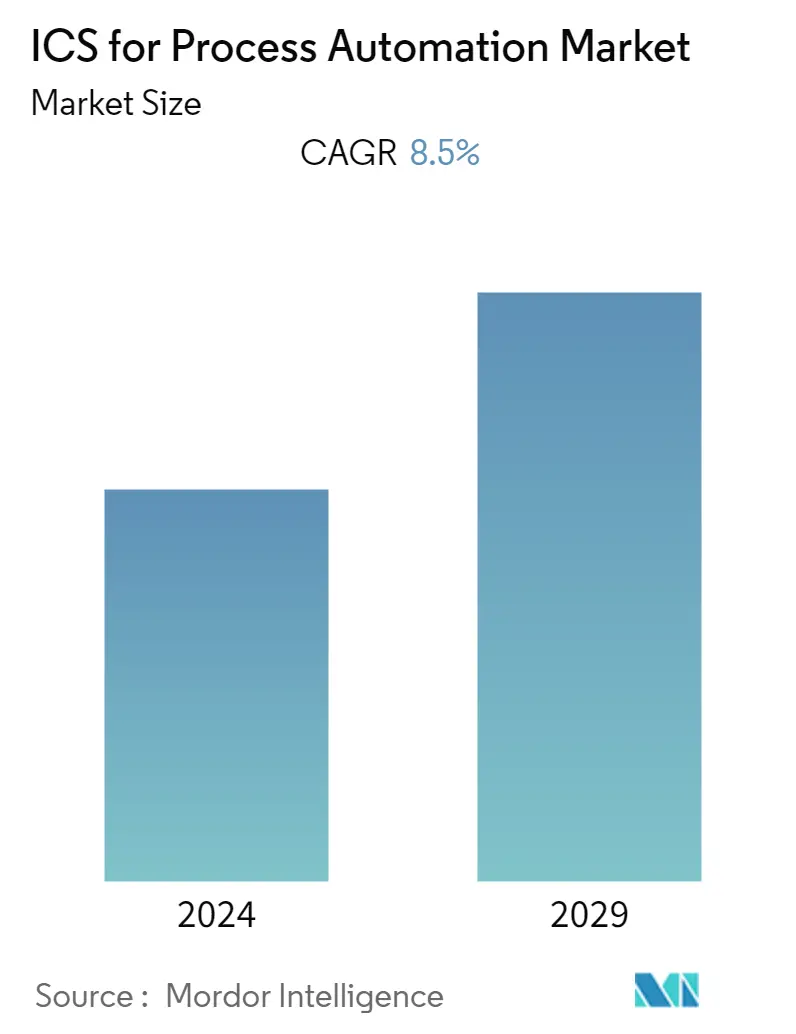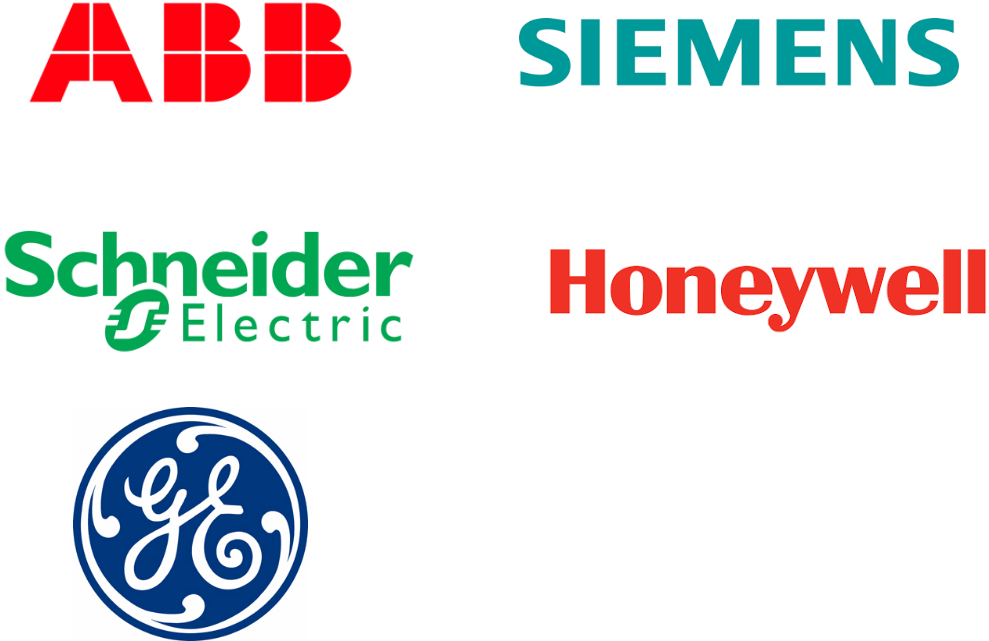Market Size of ICS for Process Automation Industry

| Study Period | 2019 - 2029 |
| Base Year For Estimation | 2023 |
| CAGR | 8.50 % |
| Fastest Growing Market | Asia Pacific |
| Largest Market | Asia Pacific |
| Market Concentration | Low |
Major Players
*Disclaimer: Major Players sorted in no particular order |
Industrial Control for Process Automation Market Analysis
The industrial control for process automation market is expected to grow at a CAGR of 8.5% over the forecast period 2021 - 2026. The Internet of Things (IIoT) and Industrial 4.0 are dominating trends in the industrial sector, with machinery and devices being connected via the internet. The number of IoT connected devices rose to 20.35 billion in 2017 from 15.41 billion in 2015 and is expected to reach 51.11 billion by 2023, given the huge push from the investment of the technology providers through continuous research and development. To operate these increasing number of connected devices and machine-to-machine connection in the manufacturing industry, the need for control and supervision is expected to become more prominent; this can be attributed to the increase of network-connected and controlled devices and systems.
- The advent of technology over the past few years has enabled the coupling of mechanical devices with computer-based systems, allowing the latter to operate and control production. This has resulted in the development of automated equipment, capable of generating significantly higher production rates, effortless monitoring, and reduced wastage over traditional machines.
- The major factor driving the growth of the market is increasing the use of enabling technologies in manufacturing, rising adoption of industrial robots in the manufacturing sector driven by collaborative robots, connected enterprise along with mass production to cater to rising population, and government initiatives toward the adoption of industrial automation in various industries.
- The rising cost of labor, coupled with the immense pressure on manufacturers to meet deadlines, has resulted in increased adoption of automation in factories. Additionally, the factors like improved efficiency and reduction in production costs, compared to the conventional manufacturing process, are boosting the adoption of automation, which is acting as a driver for industrial control systems.
- Moreover, the operations of DCS, PLC, SCADA, and MES are complex and require a highly-skilled workforce. Furthermore, initial investment associated with a traverse from an assembly line through automated production line is expected to be high. Along with it, the cost involved in training the employees with the usage of the new sophisticated equipment is also added, which could be unaffordable for certain small- and medium-sized end users. These factors are hindering the market growth
Industrial Control for Process Automation Industry Segmentation
| By System | |
| Supervisory Control and Data Acquisition System (SCADA) | |
| Distributed Control System (DCS) | |
| Programmable Logic Controller (PLC) | |
| Machine Execution System (MES) | |
| Product Lifecycle Management (PLM) | |
| Enterprise Resource Planning (ERP) | |
| Human Machine Interface (HMI) | |
| Other Systems |
| By End-user Vertical | |
| Oil and Gas | |
| Chemical and Petrochemical | |
| Power | |
| Life Sciences | |
| Food and Beverage | |
| Metals and Mining | |
| Other End-user Verticals (Water and Wastewater, Pulp and Paper, Cement, Glass, and Textile, among others) |
| Geography | |
| North America | |
| Europe | |
| Asia-Pacific | |
| Latin America | |
| Middle East & Africa |
ICS for Process Automation Market Size Summary
The industrial control for process automation market is experiencing significant growth, driven by the integration of the Internet of Things (IIoT) and Industry 4.0 technologies. These advancements have led to the connectivity of machinery and devices, necessitating enhanced control and supervision systems to manage the increasing number of network-connected devices in manufacturing. The market is propelled by the rising adoption of enabling technologies, such as industrial robots and collaborative systems, which are essential for meeting the demands of mass production and improving efficiency. However, the complexity of operations involving Distributed Control Systems (DCS), Programmable Logic Controllers (PLC), Supervisory Control and Data Acquisition (SCADA), and Manufacturing Execution Systems (MES) requires a skilled workforce, and the high initial investment and training costs pose challenges, particularly for small and medium-sized enterprises.
The paper and pulp industry exemplifies the benefits of process automation, where it facilitates efficient monitoring and control of production processes, thereby enhancing productivity and reducing wastage. The demand for paper and related products is expected to grow, driven by increased consumption in Asia, North America, and Europe. In these regions, process automation is crucial for optimizing raw material utilization and overcoming production bottlenecks. The Asia-Pacific region is anticipated to dominate the market due to the rapid adoption of automation technologies and supportive government initiatives in countries like China, South Korea, and Indonesia. In contrast, developed regions such as Europe and North America have reached saturation, offering limited growth opportunities. The market is highly competitive, with key players like ABB Ltd., Schneider Electric, Honeywell International Inc., Siemens AG, and General Electric Co. leading the charge in innovation and implementation of advanced industrial control systems.
ICS for Process Automation Market Size - Table of Contents
-
1. MARKET DYNAMICS
-
1.1 Market Overview
-
1.2 Introduction to Market Dynamics
-
1.3 Market Drivers
-
1.3.1 Increasing Industrial Automation
-
1.3.2 Rise in Infrastructure Investments
-
1.3.3 Growth in Demand for Process Automation Among Different Industry Verticals
-
1.3.4 Need for Process and Energy Efficiency
-
-
1.4 Market Restraints
-
1.4.1 Lack of Skilled Workforce
-
1.4.2 High Capital Investment
-
-
1.5 Industry Value Chain Analysis
-
1.6 Industry Attractiveness - Porter's Five Force Analysis
-
1.6.1 Bargaining Power of Buyers/Consumers
-
1.6.2 Bargaining Power of Suppliers
-
1.6.3 Threat of New Entrants
-
1.6.4 Threat of Substitute Products
-
1.6.5 Intensity of Competitive Rivalry
-
-
-
2. MARKET SEGMENTATION
-
2.1 By System
-
2.1.1 Supervisory Control and Data Acquisition System (SCADA)
-
2.1.2 Distributed Control System (DCS)
-
2.1.3 Programmable Logic Controller (PLC)
-
2.1.4 Machine Execution System (MES)
-
2.1.5 Product Lifecycle Management (PLM)
-
2.1.6 Enterprise Resource Planning (ERP)
-
2.1.7 Human Machine Interface (HMI)
-
2.1.8 Other Systems
-
-
2.2 By End-user Vertical
-
2.2.1 Oil and Gas
-
2.2.2 Chemical and Petrochemical
-
2.2.3 Power
-
2.2.4 Life Sciences
-
2.2.5 Food and Beverage
-
2.2.6 Metals and Mining
-
2.2.7 Other End-user Verticals (Water and Wastewater, Pulp and Paper, Cement, Glass, and Textile, among others)
-
-
2.3 Geography
-
2.3.1 North America
-
2.3.2 Europe
-
2.3.3 Asia-Pacific
-
2.3.4 Latin America
-
2.3.5 Middle East & Africa
-
-
ICS for Process Automation Market Size FAQs
What is the current ICS for Process Automation Market size?
The ICS for Process Automation Market is projected to register a CAGR of 8.5% during the forecast period (2024-2029)
Who are the key players in ICS for Process Automation Market?
ABB Ltd., Schneider Electric, Honeywell International Inc., Siemens AG and General Electric Co. are the major companies operating in the ICS for Process Automation Market.

